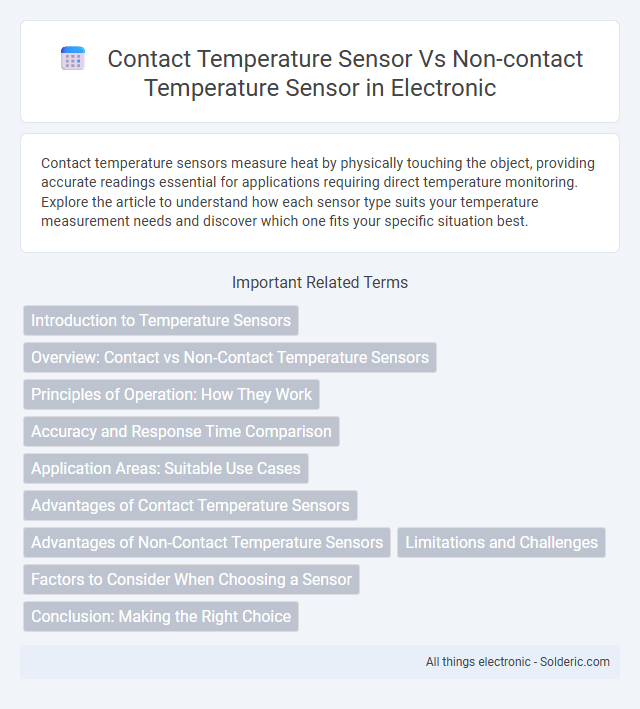Contact temperature sensors measure heat by physically touching the object, providing accurate readings essential for applications requiring direct temperature monitoring. Explore the article to understand how each sensor type suits your temperature measurement needs and discover which one fits your specific situation best.
Comparison Table
| Feature | Contact Temperature Sensor | Non-Contact Temperature Sensor |
|---|---|---|
| Measurement Method | Direct physical contact with the object | Measures infrared radiation emitted by the object |
| Response Time | Typically slower due to thermal conduction | Fast, provides near-instant readings |
| Accuracy | Generally higher accuracy on stable surfaces | Accuracy affected by emissivity and distance |
| Application | Ideal for liquids, semi-solids, and direct contact surfaces | Best for hazardous, moving, or hard-to-reach objects |
| Hygiene & Safety | Requires cleaning; possible contamination risk | Non-invasive; no risk of contamination |
| Durability | Subject to wear and damage from physical contact | Less wear; sensor protected from direct contact |
| Cost | Typically lower cost | Usually higher initial cost |
Introduction to Temperature Sensors
Temperature sensors are devices that measure the temperature of a system or environment by detecting heat energy. Contact temperature sensors, such as thermocouples and resistance temperature detectors (RTDs), require direct physical contact with the object to accurately gauge temperature. Non-contact temperature sensors, like infrared thermometers, measure temperature from a distance by detecting emitted radiation, making them ideal for moving or hazardous objects where physical contact is impractical.
Overview: Contact vs Non-Contact Temperature Sensors
Contact temperature sensors directly measure the temperature by physical touch, offering precise readings ideal for solids, liquids, and stable environments. Non-contact temperature sensors use infrared radiation to measure surface temperatures from a distance, making them suitable for moving objects, hazardous materials, or areas where contamination must be avoided. Your choice depends on the application specifics such as accuracy needs, environmental conditions, and surface accessibility.
Principles of Operation: How They Work
Contact temperature sensors operate by physically touching the object, allowing heat to transfer directly to the sensor's thermally sensitive element, enabling accurate and stable temperature readings. Non-contact temperature sensors measure infrared radiation emitted by an object's surface, converting this energy into a temperature value without physical interaction, ideal for moving or hazardous materials. Your choice depends on the application's requirements for precision, response time, and environmental conditions.
Accuracy and Response Time Comparison
Contact temperature sensors, such as thermocouples and resistance temperature detectors (RTDs), offer high accuracy by directly measuring the temperature through physical contact, providing precise readings with minimal interference. Non-contact temperature sensors like infrared thermometers deliver faster response times by detecting emitted thermal radiation, allowing quick measurements from a distance but with slightly reduced accuracy due to emissivity variations and environmental factors. Your choice depends on balancing the need for precise temperature data versus rapid measurement turnaround in your specific application.
Application Areas: Suitable Use Cases
Contact temperature sensors, such as thermocouples and resistance temperature detectors (RTDs), excel in industrial environments requiring direct measurement of solids, liquids, and gases, ideal for HVAC systems, manufacturing processes, and laboratory experiments. Non-contact temperature sensors, including infrared and thermal cameras, are crucial for applications needing rapid temperature assessment without physical contact, such as electrical inspections, medical diagnostics, food safety, and moving or hazardous objects. Each sensor type addresses specific needs based on accessibility, accuracy, and environmental safety considerations, making them complementary tools in temperature monitoring.
Advantages of Contact Temperature Sensors
Contact temperature sensors offer precise and reliable measurements by physically touching the object, ensuring accurate temperature readings in various industrial applications. They are highly effective for monitoring solid surfaces or liquids where direct contact is possible, providing consistent data unaffected by environmental factors such as dust or smoke. Your choice of a contact sensor ensures durability and cost-efficiency in processes requiring stable and continuous temperature monitoring.
Advantages of Non-Contact Temperature Sensors
Non-contact temperature sensors offer significant advantages including the ability to measure temperature from a distance, which enhances safety when monitoring hazardous or moving objects. These infrared sensors provide rapid response times and are ideal for applications where physical contact is impractical or could influence the measurement accuracy, such as in electrical equipment, food processing, and manufacturing. Their non-intrusive nature reduces wear and maintenance requirements, improving long-term reliability and operational efficiency.
Limitations and Challenges
Contact temperature sensors face limitations such as slower response times due to thermal conduction requirements and potential damage when used on fragile or moving surfaces. Non-contact temperature sensors struggle with challenges including measurement accuracy affected by emissivity variations, surface reflections, and environmental factors like dust or smoke. Both sensor types encounter difficulties in extreme temperature ranges and require calibration for precise readings.
Factors to Consider When Choosing a Sensor
Choosing between contact and non-contact temperature sensors depends on factors such as the type of surface, measurement environment, and required accuracy. Contact sensors offer precise readings for solids or liquids but may affect the object's temperature, while non-contact sensors provide rapid measurements suitable for moving or hazardous surfaces without physical interference. Your decision should balance the need for accuracy, response time, application conditions, and ease of sensor installation.
Conclusion: Making the Right Choice
Choosing between a contact temperature sensor and a non-contact temperature sensor depends on your specific application requirements such as accuracy, response time, and environmental conditions. Contact sensors provide direct measurement and high precision but may influence the temperature of the target due to physical contact, whereas non-contact sensors offer rapid readings without affecting the object, ideal for moving or hazardous surfaces. Understanding these differences ensures that you select the most effective temperature sensing solution for your operational needs.
Contact temperature sensor vs non-contact temperature sensor Infographic

 solderic.com
solderic.com